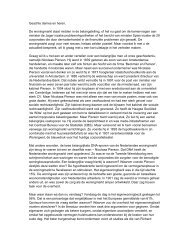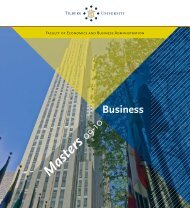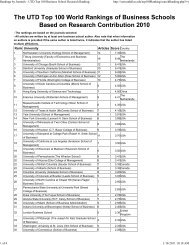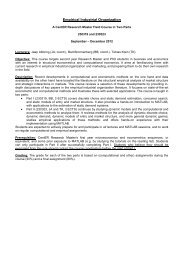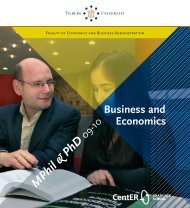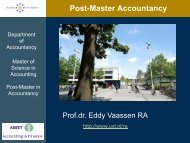Predicting the past - Tilburg University, The Netherlands
Predicting the past - Tilburg University, The Netherlands
Predicting the past - Tilburg University, The Netherlands
You also want an ePaper? Increase the reach of your titles
YUMPU automatically turns print PDFs into web optimized ePapers that Google loves.
This book also contains a second experiment, on ‘tacit knowledge’. Tacit knowledge is <strong>the</strong><br />
sort of thing that is not written down but which <strong>the</strong> pupil learns by watching <strong>the</strong> master<br />
at work. For example, if I consult a cookbook, <strong>the</strong>n I have a hard time to prepare a dish,<br />
because I lack experience and many things are taken for granted and are not written down.<br />
<strong>The</strong> collection of <strong>the</strong>se things is called tacit knowledge. Our tacit knowledge experiment<br />
was particularly striking, because it produced results which were completely opposite to<br />
what we and everybody else had expected, namely that our colleagues who advertise <strong>the</strong>ir<br />
methods most forcefully turned out to be not <strong>the</strong> easiest but <strong>the</strong> most difficult to imitate.<br />
Interlude on intuition<br />
Research, one often hears, starts with asking <strong>the</strong> right question. When is a question <strong>the</strong><br />
right question? What does ‘right’ mean? Here we enter <strong>the</strong> domain of intuition. We need<br />
intuition to formulate a question that is relevant, excites us, and will be of interest to<br />
o<strong>the</strong>rs too, but in such a way that it is nei<strong>the</strong>r too easy (so that anybody could solve it) nor<br />
too difficult (so that you cannot solve it). We also need intuition to reduce <strong>the</strong> number of<br />
paths to solve a problem, once we have formulated it.<br />
Intuition, however, is a slippery customer and it needs constant care and attention. Poor<br />
results or counterintuitive outcomes (and <strong>the</strong>se occur all <strong>the</strong> time) should not simply be<br />
dismissed. Each time we have to ask: why do we find a result that is counterintuitive? Are<br />
<strong>the</strong> data wrong, is <strong>the</strong> model wrong, is <strong>the</strong> estimation method inappropriate? Or perhaps<br />
our intuition is wrong and <strong>the</strong> result is in fact a sensible outcome, just different from what<br />
we expected. Only <strong>the</strong>n, I am convinced, can we sharpen our intuition and avoid <strong>the</strong> same<br />
mistake next time. <strong>The</strong>n we will have learned something and this will prove useful in our<br />
future research.<br />
Consider <strong>the</strong> following case, inspired by Tversky and Kahneman’s famous article, which<br />
appeared in Science in 1974.<br />
<strong>The</strong> town of <strong>Tilburg</strong> has two hospitals, a large one and a small one. In <strong>the</strong> larger<br />
hospital 45 babies are born each day, and in <strong>the</strong> smaller hospital 15 babies are born<br />
each day. About 50% of <strong>the</strong> babies are boys, but <strong>the</strong> exact percentage varies from<br />
day to day. Sometimes it is higher than 50%, sometimes lower. Over a period of<br />
one year, each hospital records <strong>the</strong> days on which more than 60% of <strong>the</strong> babies<br />
were boys. Which hospital do you think recorded more such days?<br />
<strong>Predicting</strong> <strong>the</strong> <strong>past</strong> 11




